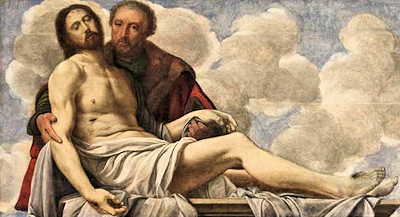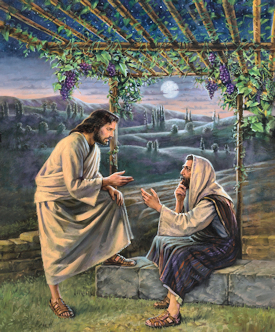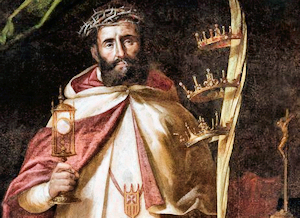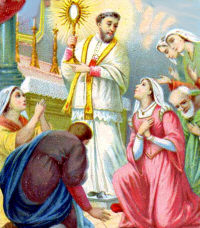Ordinary Time: August 31st
Wednesday of the Twenty-Second Week of Ordinary Time
Other Commemorations: Sts. Joseph of Arimathea and Nicodemus (RM); St. Raymond Nonnatus (RM)
» Enjoy our Liturgical Seasons series of e-books!
According to the 1962 Missal of Bl. John XXIII the Extraordinary Form of the Roman Rite, today is the feast of St. Raymund Nonnatus who devoted his life to the ransoming of Christians held prisoner by the Mohammedans. He was one of the first members of the Order of Our Lady of Ransom (or Mercedarians) founded by St. Peter Nolasco and St. Raymund of Penafort. Having been sent to Africa he obtained the freedom of many captives; he offered his own person as a pledge for ransom that was not forthcoming in order to preserve from apostasy those whose faith was wavering. When he was set free he was made a Cardinal by Gregory IX and died on his return to Rome in 1240.
St. Joseph of Arimathea
1st century. We read about Joseph of Arimathea, the “noble counsellor,” in all four Gospels (Matthew 27:57-61; Mark 15:43-46; Luke 23:50-56; and John 19:38-42). As with many of the Biblical figures, numerous legends accrued around his name in later years.
 Saint Joseph was a wealthy member of the temple council and a secret follower of Jesus because he was afraid of persecution from Jewish officials. He attended the Crucifixion, and legend has it that he caught Jesus’s blood as he hung upon the cross. (What is said to be the Sacro Catino in which Joseph caught the blood of Christ at the Crucifixion is at San Lorenzo, Genoa, Italy.) Joseph persuaded Pontius Pilate to let him have Jesus’s body, wrapped it in linen and herbs, and laid it in a tomb carved in a rock in the side of a hill, a tomb that he had prepared for himself.
Saint Joseph was a wealthy member of the temple council and a secret follower of Jesus because he was afraid of persecution from Jewish officials. He attended the Crucifixion, and legend has it that he caught Jesus’s blood as he hung upon the cross. (What is said to be the Sacro Catino in which Joseph caught the blood of Christ at the Crucifixion is at San Lorenzo, Genoa, Italy.) Joseph persuaded Pontius Pilate to let him have Jesus’s body, wrapped it in linen and herbs, and laid it in a tomb carved in a rock in the side of a hill, a tomb that he had prepared for himself.
Later tradition has embellished this account to add that Joseph was a distant relative of Jesus, who derived his wealth from tin mines in Cornwall, which he visited from time to time. One version tells the story of the teenage Jesus accompanying Joseph on one such visit. This is the background of the poem “Jerusalem,” by William Blake (1757-1827):
And did those feet in ancient time
Walk upon England’s mountains green?
And was the holy Lamb of God
On England’s pleasant pastures seen?
And did the countenance divine
Shine forth upon our clouded hills?
And was Jerusalem builded here
Among those dark satanic mills?
Bring me my bow of burning gold!
Bring me my arrows of desire!
Bring me my spear!
O clouds, unfold!
Bring me my chariot of fire!
I will not cease from mental fight,
Nor shall my sword sleep in my hand,
Till we have built Jerusalem
In England’s green and pleasant land.
This version continues to say that, after the Crucifixion, Saint Joseph returned to Cornwall, bringing with him the chalice of the Last Supper, known as the Holy Grail. The Holy Grail was hidden and played an important part in the folk history of England in the great national epic about King Arthur and his knights who unsuccessful seek to find it.
Upon reaching Glastonbury, he planted his staff, which took root and blossomed into a thorn tree. This is the Holy Thorn, which flowers at Christmas. King Charles I baited his wife’s Roman Catholic chaplain by observing that, although Pope Gregory had proclaimed a reform of the calendar, the Glastonbury Thorn ignored the Pope’s decree and continued to blossom on Christmas Day according to the Old Calendar. One of Cromwell’s soldiers cut down the Thorn because it was a relic of superstition. We are told that he was blinded by one of the thorns as it fell. A tree allegedly grown from a cutting of the original Thorn survives today in Glastonbury (and trees propagated from it stand on the grounds of the Cathedral in Washington, DC, and presumably elsewhere) and leaves from it are sold in all the tourist shops in Glastonbury.
It was not until about the middle of the 13th century that the legend appears saying Joseph accompanied Saint Philip to Gaul to preach and was sent by him to England as the leader of 12 missionaries. It is said that the company, inspired by Gabriel the archangel, built a church made of wattles in honor of the Virgin Mary on an island called Yniswitrin, given to them by the king of England. The church eventually evolved into Glastonbury Abbey in Somerset. Supposedly Joseph died there, was buried on the island, and miraculous cures worked at his grave. This burial site is unlikely though.
Is there any merit to the legends of Saint Joseph? Perhaps. Tin, an essential ingredient of bronze, was highly valued in ancient times, and Phoenician ships imported tin from Cornwall. It is not unreasonable to believe that some first-century, Jewish Christians might have been investors in the Cornwall tin trade. Christianity gained a foothold in Britain very early, perhaps, in part, because of the commerce in tin. If so, then the early British Christians would have a tradition that they had been evangelized by a wealthy Jewish Christian. Having forgotten his name, they might have consulted the Scriptures and found that Joseph and Saint Barnabas fit the description. Because much of the life of Barnabas was already described by the Acts of the Apostles making him an unlikely candidate, only Joseph was left. Thus, Christians seeking an immediate connection with their Lord, grasped on to Joseph as their evangelizer (Attwater, Benedictines, Bentley, Delaney, Encyclopedia, Robinson, White).
In art, Saint Joseph is portrayed as a very old man, carrying a pot of ointment or a flowering staff or a pair of altar cruets (containing the blood and sweat of Jesus) (White). He may be shown taking the crown of thorns from the dead Christ. At other times he is shown with the shroud and crown of thorns, a thorn tree by him, or a box of spices (Roeder). Click here to see William Blake’s Joseph of Arimathea among the Rocks of Albion. He is venerated at Glastonbury and patron of grave-diggers and undertakers (Roeder, White).
—Taken from Saints of the Day
Symbols and Representation: very old man carrying a pot of ointment; very old man carrying a flowering staff; very old man carrying a pair of altar cruets; flowering staff
Patronage: coffin-bearers; funeral directors; gravediggers; morticians; pallbearers; tin miners; tin smiths; undertakers; Catholic Cemeteries of the Archdiocese of Vancouver; Glastonbury cathedral
Highlights and Things to Do;
- Read more about St. Joseph of Arimathea:
- Read more about the Glastonbury Legends
- here and here. Also read about the Glastonbury Thorn.
- Visit the Shrine of Our Lady of Glastonbury.
St. Nicodemus
 Nicodemus was a member of the Sanhedrin in Israel during the life of Jesus. He was a secret disciple of Christ, meeting him by night to avoid the wrath of the other members of the Sanhedrin.
Nicodemus was a member of the Sanhedrin in Israel during the life of Jesus. He was a secret disciple of Christ, meeting him by night to avoid the wrath of the other members of the Sanhedrin.
Saint John tells us that Nicodemus came to see Jesus, secretly and at night, to talk to him about what it means to see the kingdom of God (John 3). On this occasion Nicodemus partly confessed his belief in Jesus, saying: “We know that you are a teacher come from God, for no one can do these signs that you do unless God is with him.” Jesus tried to teach him about being born again by the Holy Spirit and by baptism. Saint John even says that it was to Nicodemus that our Lord said, “God so loved the world that He gave His only Son, that whoever believes in him should not perish but have eternal life.”
Nicodemus spoke out on Jesus’ behalf before the chief priests and the Pharisees, pointing out to them that the Law demanded the accused be given a hearing before judgment was passed (John 7:50- 52)..
Together with Saint Joseph of Arimathea he prepared Jesus’ body and placed him in the tomb on Good Friday. He brought with him large quantities of costly myrrh and aloes to the tomb and with Joseph wrapped Jesus’ body “with spices in linen cloth” (John 1939-42).
One of the apocryphal gospels was circulated under his name in the early centuries of the Church, although it is sometimes entitled the Acts of Pilate. Saint Nicodemus has always been venerated as a martyr, although nothing is mentioned about his conversion or martyrdom in the New Testament.
—Adapted from CatholicSaints.info and Saints of the Day – Nicodemus
Symbols and Representation: Pharisee
Highlights and Things to Do:
- Read more about St. Nicodemus:
St. Raymond Nonnatus
 Peter Nolasco, a native of Languedoc, founded in the early thirteenth century a society known as the Mercedarians, devoted to ransoming Christians captured by the Moors.
Peter Nolasco, a native of Languedoc, founded in the early thirteenth century a society known as the Mercedarians, devoted to ransoming Christians captured by the Moors.
Amongst those he received into the society was a Catalonian named Raymond. This Raymond's mother had died giving birth to her son, and he was delivered by a caesarian section — hence his nickname Nonnatus, which is Latin for 'not born'. So determined was Saint Raymond Nonnatus that when Peter Nolasco retired as chief ransomer, the saint succeeded him in this office. He set off for Algiers with a great sum of money, and there ransomed many.
When his money ran out, Saint Raymond Nonnatus could have made his own escape. But this would have involved leaving several slaves behind. He gave himself up in exchange for their liberty.
His own life was now in great danger. The Moors of Algiers were enraged that he had managed to convert some of their number. The governor would have put him to death by impaling the saint on a stake. What saved him were others who realized that a rich ransom would be paid for this particular Christian. Even so, he was still whipped publicly in the streets — partly to discourage those who might be tempted to learn from him the Christian faith. Reports of his tortures probably exaggerated the cruelty of his Moorish captors but after eight months of torture, Peter Nolasco arrived with Raymond Nonnatus's ransom. Even then he wanted to stay behind, hoping to convert still more men and women to Christianity; but Peter Nolasco forbade it.
On his return, Pope Gregory IX made him a cardinal. The pope wished to see Raymond Nonnatus in Rome, but on his way there in the year 1240 he reached only Cardona near Barcelona, where he died at the age of thirty-six.
—Excerpted from A Calendar of Saints by James Bentley
Patronage: against fever; babies; childbirth; children; domestic animals; expectant mothers; falsely accused people; infants; midwives; newborn babies; obstetricians; pregnant women; Mercedarian novices; Baltoa, Dominican Republic; San Ramon, Costa Rica
Symbols and Representation: Padlock; crown of thorns; three or four crowns; Mercedarian surrounded by Moors and prisoners; Mercedarian surrounded by ransomed slaves; Mercedarian with a cardinal‘s red hat; Mercedarian with a padlock on his lips
Highlights and Things to Do:
- Read more about St. Raymond:
- Learn a little bit about the history and geographic region of Catalonia, Spain — St. Raymond's birthplace.
- Read the life of St. Raymond from The Lives of the Fathers, Martyrs, and Other Principal Saints.
- If you are expecting a child the blessing before childbirth is a beautiful spiritual preparation.
- The name "Nonnatus" might sound familiar to those who have watched the series "Call the Midwife." Nonnatus is indeed named after St. Raymond Nonnatus.






